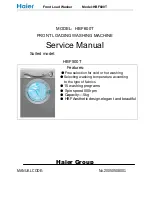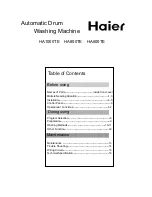
SKU 95338
PAGE 14
for technical questions, please call 1-800-444-3353;
troubleshooting section at end of manual.
Setup
CHECK THE WATER SUPPLY.
Prior to using the Pressure Washer for the first time,
it is ESSENTIAL to verify that the water supply is adequate. The Pressure Washer
needs TWICE the water supply (or volume) than the stated water output (2.1 GPM).
This Pressure Washer will need about 3-4 GPM to operate correctly and efficiently.
If the water is being supplied by a well/pump, make certain that the well/pump
produces enough water to keep up with the Pressure Washer’s water demands.
Water supply hoses should be heavy duty to withstand the forces involved. Water
hoses up to 25’ long must be
5
/
8
” ID. Water hoses up to 50’ long must be
3
/
4
” ID.
Do not use hoses longer than 50’. The more minerals in the water (the harder the
water) you use, the more often mineral buildup will need to be cleaned out from the
nozzles.
Flow rate of the water supply must never be allowed to fall below 3 GPM.
To determine the water supply’s flow rate: Run the water at full for one minute into
a 5 gallon container, and measure the amount of water in the container.
CAUTION! If the Pressure Washer is run with an inadequate water supply, the
pump will cavitate. Cavitation causes the pump to operate loudly and will damage it.
ARRANGE FOR A PROPER ELECTRICAL SUPPLY. This unit uses a large amount
of current, especially during start-up. Connect this unit only to a dedicated household
circuit capable of providing ample current to it. A dedicated circuit has no additional
loads (running devices) connected to it; shut off any appliances or lights that dim or
slow down while the washer is running. For best results, connect the plug to that
circuit’s outlet that is nearest to the circuit breaker panel.
MAKE SURE THE WASHER IS CLEAN AND READY FOR USE. Ensure the inlet
water strainer, nozzle, and the rest of the Washer are totally free of buildup or debris.
PLAN OUT THE JOB: Plan out what areas will be cleaned, how many sessions will
be necessary, and how long the individual sessions of work will need to be. Plan
to clean the higher portions first, because the higher portions will typically remain
cleaner while the other areas are cleaned. Plan a safe direction for runoff to flow
while the job is being performed, and plan on working your way in that direction.
You will have a clearer idea of the time involved to clean the area after doing a test
run, as explained on page 16, #3.
PREPARE THE CLEANING AREA. Clear the cleaning area of all objects that are
not being cleaned. If any water prone or delicate items cannot be moved, protect
or move them. If detergent is to be used, cover or remove any plants or animals
that may be damaged by the chemicals in the cleaner.
PLACE THE PRESSURE WASHER IN AN APPROPRIATE LOCATION. The loca-
tion should be protected from any water from the cleaning area; if possible, select
a location higher than the cleaning area. The pressure washer’s location should
be close enough so that the hose will reach every portion of the job to be done with
1.
2.
3.
4.
5.
6.















































